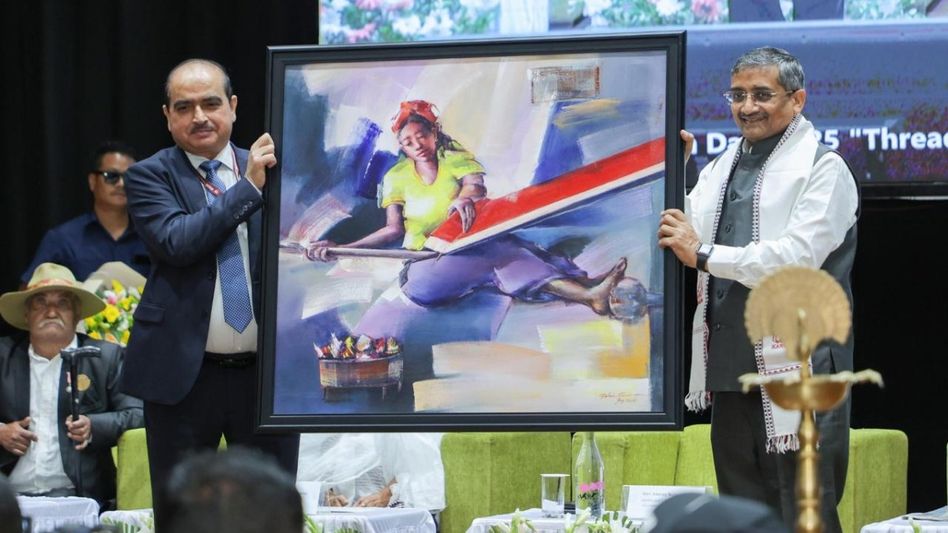Manipur observes National Handloom Day celebrating heritage, empowerment and innovation
Manipur joined the rest of the nation in celebrating National Handloom Day with a vibrant and insightful programme held at the City Convention Centre, Imphal on August 7. The theme for this year’s celebration, “Threads of Tradition: Weaving Culture Through Handlooms,” paid homage to the enduring legacy of the weaver community while highlighting the sector’s growing role in economic development.

Manipur joined the rest of the nation in celebrating National Handloom Day with a vibrant and insightful programme held at the City Convention Centre, Imphal on August 7. The theme for this year’s celebration, “Threads of Tradition: Weaving Culture Through Handlooms,” paid homage to the enduring legacy of the weaver community while highlighting the sector’s growing role in economic development.
Delivering the keynote address, Chief Secretary Dr Puneet Kumar Goel described the day as a moment of reflection and recognition. “It is a special occasion to celebrate the creativity, self-reliance, and invaluable contributions of our weavers and artisans,” he said.
Dr Goel underscored the deep cultural roots of Manipur's handloom traditions—from the iconic Phanek and Moirang Phee to the finely woven Wangkhei Phee. “Each piece is not just fabric, but a narrative of our heritage passed through generations. With over 2.5 lakh handloom workers, predominantly women, Manipur holds a prominent position on India’s handloom map,” he noted. The state boasts over 750 unique design motifs and 26 recognized handicrafts, reflecting its rich artisanal identity.
The Chief Secretary highlighted the government’s continued commitment to the sector, describing handloom and handicrafts as key engines of inclusive growth. In collaboration with the Ministry of Textiles, Government of India, the Manipur government has rolled out a number of initiatives under the National Handloom Development Programme (NHDP).
These include:
Cluster Development Projects providing infrastructure, raw material banks, and skill upgradation.
Direct Benefit Transfers and Weaver MUDRA loans, supporting thousands of artisans financially.
Issuance of Handloom ID cards to ensure transparency and inclusion.
Training and design innovation via institutions like IIHT and NIFT.
Promotion of signature products like Moirang Phee (Bishnupur) and Kauna craft (Thoubal) under the One District One Product (ODOP) initiative.
Further, efforts are underway to align traditional skills with the digital economy through e-commerce integration, digital payments, and social media marketing. Weavers are being provided with free looms and accessories, subsidized yarns, and support for GI tagging and global branding.
While celebrating the sector’s successes, Dr Goel acknowledged ongoing challenges including limited credit access, marketing bottlenecks, raw material scarcity, and the need for contemporary design knowledge.
He outlined the state’s roadmap for the future:
Establishing Common Worksheds in handloom-intensive blocks
Promoting youth entrepreneurship through start-up initiatives
Facilitating designer-artisan collaborations
Promoting sustainability in production
Linking artisans to international markets
The vision, he said, is to evolve the handloom sector from a cultural practice into a globally competitive industry that empowers communities.
Also speaking at the event, Additional Chief Secretary (Textiles, Commerce & Industry), Anurag Bajpai recalled the historical roots of National Handloom Day, which commemorates the Swadeshi Movement of 1905—a turning point that ignited the spirit of self-reliance across India.
“For Manipur, this day holds even greater meaning,” he said. “Handloom here is not just livelihood—it is a representation of India’s civilizational values, rural empowerment, and creative resilience.”
A short film titled “Manipur: Threads of Heritage, Hands of Prosperity” was screened during the event, followed by the launch of the book “From Loom to Legacy: Crafts Story of Manipur.” The event also honoured distinguished artisans including Padma Shri Shilp Guru Machihan Sasa, Padma Shri Radhe Sharmi, Shilp Guru G. Shanti Devi, and others.
Among the prominent attendees were Aurineeta Das, Associate Professor, NIFT Shillong; National Awardee K. Medha Devi; and Elangbam Jeeten, Director, Handloom & Textiles, Manipur.
The event concluded with renewed commitment to empowering artisans, preserving traditional designs, and weaving Manipur’s cultural identity into the fabric of national progress.
Copyright©2025 Living Media India Limited. For reprint rights: Syndications Today









